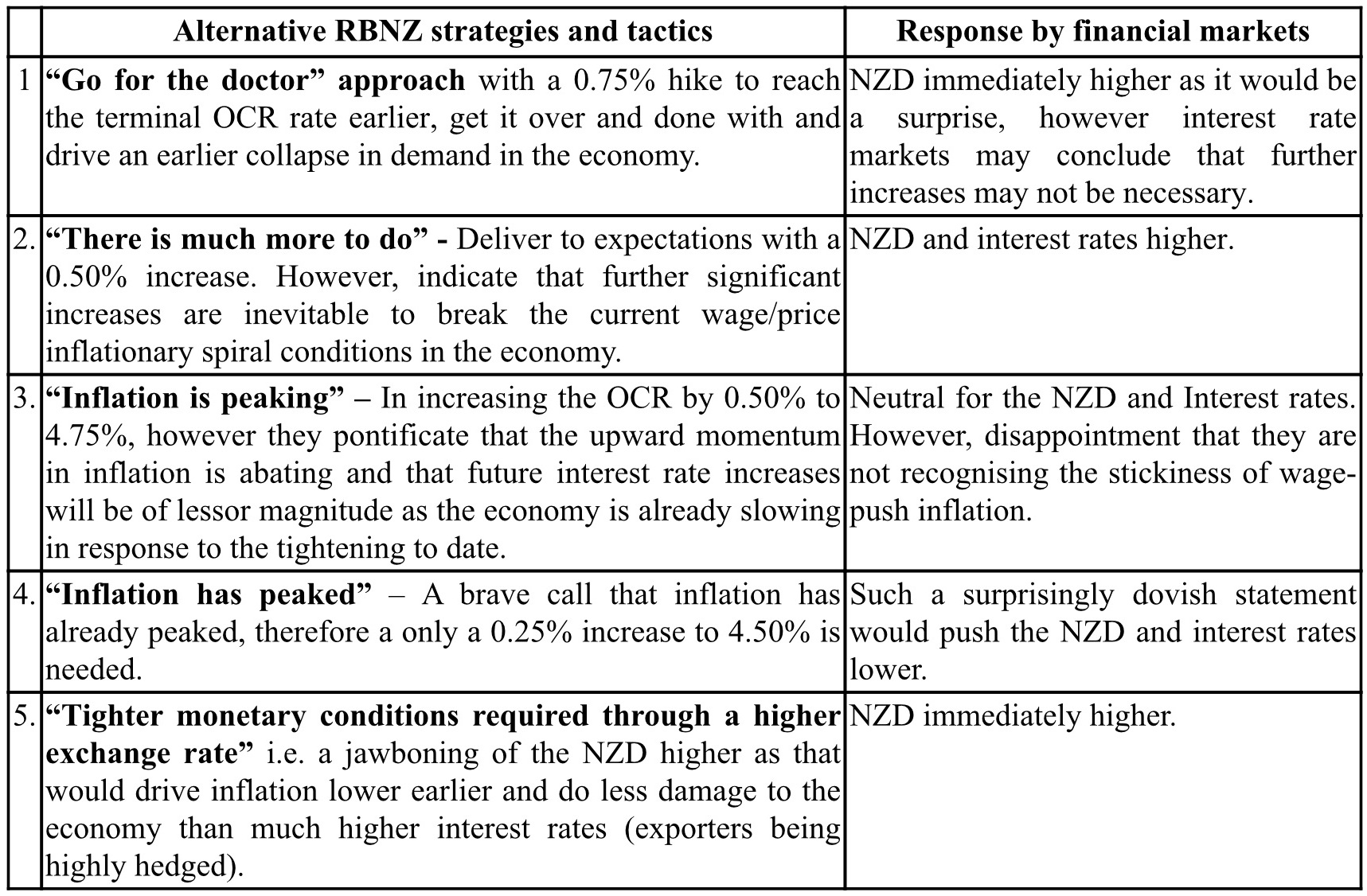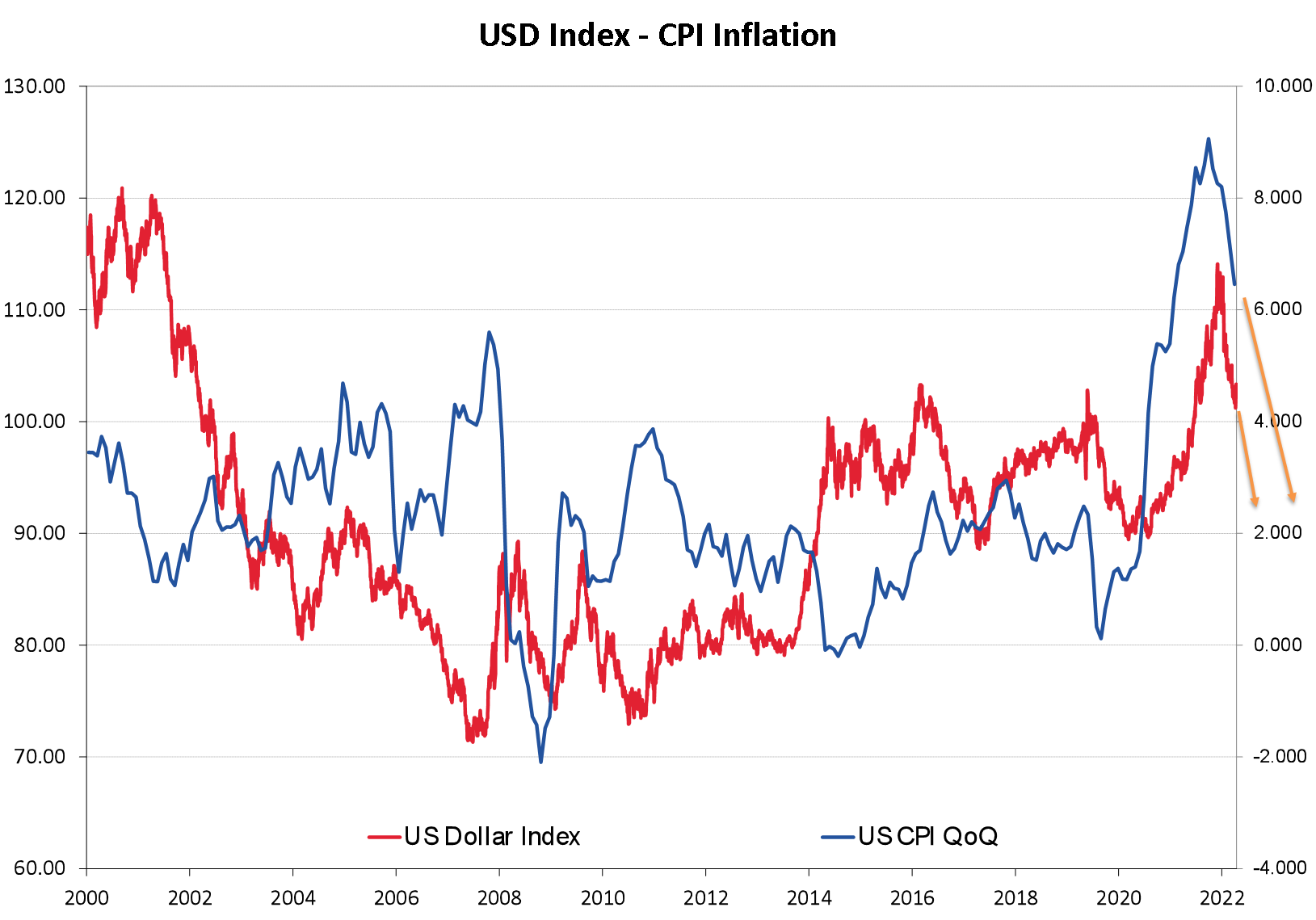
-
Summary of key points: -
- Central banks’ interest rate decisions dominating currency movements
- Alternative strategies and tactics the RBNZ could adopt
- US inflation trends against lagged jobs trends causing confusion for the markets
Central banks’ interest rate decisions dominating currency movements
The interest rate decisions and statements on their economic/inflation outlook from central bankers around the world continues to dominate currency movements.
Monetary policy decisions to pull inflation back down again from the Covid-era fiscal and monetary excesses, that caused spectacular increases in inflation, is the order of the day.
Foreign exchange markets are reacting to the central bank interest rate decisions and any forward guidance provided. FX markets are always pricing-in expected future monetary conditions and interest rate differentials well in advance and this influence is swamping-out other economic and market news as FX rate shifting forces.
Central banks are at different stages of the monetary tightening process, as was evidenced with interest rate decisions and statements over the last two weeks: -
- The US Federal Reserve lifted their official interest rate by 0.25% to 4.50%/4.75% on 2nd February. Governor Jerome Powell was leaning to the dovish side in the following media conference, indicating that they were near the end of their tightening cycle with the annual inflation rate falling faster than they expected. However, the subsequent boomer jobs number for January has shunted market interest rates and the USD sharply higher since.
- The European Central Bank (“ECB”) increased their official interest rate by 0.50% to 3.00% last week on 8th February. With European inflation above 10% and the expected economic catastrophe from the energy crisis avoided (due to mild winter climatic conditions and new sources of gas), the way is now clear for the ECB to be much more aggressive with future interest rate hikes. They have a lot more tightening to do and two further 0.50% interest rate increases over coming months must be positive for the Euro currency value.
- The Bank of England lifted their official bank interest rate by 0.50% on 2nd February to 4.00%. Market pricing is for a UK terminal rate of 4.40% by July this year, therefore similar to the US they are also nearing the end of the tightening cycle.
- The Reserve Bank of Australia (“RBA”) have adopted a slower pace of interest rate increase since late last year. The RBA increased their OCR by 0.25% to 3.35% on 7th February and signalled that further rate hikes are needed (however dependent upon evolving economic data). The RBA has been the most hesitant and indecisive central bank with monetary policy tightening to bring inflation down. The problem they currently have is that their annual inflation rate is 7.80% and it is still rising with higher wage increases now coming through. The RBA forecast that their OCR will increase further to 4.25% by the end of this year, however more unfavourable inflation outcomes will have market pricing moving above that. The RBA appears to be yet again behind the 8-ball with combating high inflation. Therefore, AUD gains have to be expected as the RBA are forced to catch up with more aggressive interest rate hikes.
In summary, the ECB and RBA still have much to do with additional monetary tightening at the same time the US Fed is clearly near the end of their tightening cycle.
The net result of this difference in timing is further EUR and AUD currency gains must be anticipated over coming weeks/months.
Alternative strategies and tactics the RBNZ could adopt
The tone of the RBNZ’s message in their monetary policy statement on Wednesday 22nd February will be just as important as their decision to increase the OCR interest rate by 0.75%, or 0.50%, or 0.25%. Market consensus has now fallen on a 0.50% increase to 4.75%, however a number of economist are suggesting a slower pace via a 0.25% lift following recent flat inflation and employment figures for the December quarter. Counteracting the view of a slower rate of increase was January electronic card transactions in the retail sector increasing by 2.60% over December.
The slowdown in consumer demand the RBNZ are attempting to orchestrate to reduce inflation is not happening yet, however mortgage rate increases will certainly hit spending over coming months.
The RBNZ have choices as to the accompanying message they desire to deliver to the financial markets and participants in the wider economy. The forward guidance message they decide upon really comes down their understanding of the root causes of our 7.20% pa inflation rate and what is the most effective method to drive it lower.
Their menu list of alternative strategies looks as follows:-

The actual tone of the RBNZ statement is likely to be between 2 and 3 above. It would be refreshing to see the RBNZ provide more analysis and comment on the reasons behind the high non-tradable/domestic inflation currently (i.e. worker shortages due to misguided immigration policies, public sector pricing behaviour and Government legislation as increasing the minimum wage by 7%). Previous inflation causes such as international energy and freight costs have now reversed the other way. Therefore, the RBNZ need to focus on the domestic causes of inflation., which largely revolve around their political masters across the road.
US inflation trends against lagged jobs trends causing confusion for the markets
The knee-jerk negative reaction by US equity, bond and FX markets to the much higher than expected employment increase in January suggests that they now see the Fed being more aggressive with monetary tightening than was the case prior to the jobs data. US inflation numbers for the month of January on Tuesday night (NZT) may well return a dose of reality to the markets in that there will be further proof that inflation is rapidly falling, and the labour market trends are extremely lagged and do not reflect what is actually happening today with hiring and firing in the USD economy.
Headline inflation in January is forecast to increase by 0.40%, which will reduce the annual rate again to 6.30%. Core inflation is forecast to lift by 0.30%, which will reduce the annual core rate to 5.40%. Any surprise outcome will be on the downside in the writer’s opinion, therefore a rebound lower in the USD and long-term US interest rates should be anticipated.
It would not have gone unnoticed by readers that US technology firms are now laying-off staff in the thousands. It is estimated that 200,000 tech jobs were lost in 2022 and so far this year another 70,000 have gone. Last week Yahoo, Zoom and eBay cut their workforce numbers, following earlier reductions by Paypal, IBM, FedEx, SAP, Spotify, Google, Microsoft and Amazon.
Hiring of leisure and hospitality workers has so far outnumbered the tech job losses. That trend will not continue for much longer. The wage rates are much lower in the hospitality sector and therefore the Fed will take comfort that overall wages pressure in the US economy is easing. One month’s jobs data is not enough for the Fed to alter course, and the inflation data this week should turn market sentiment to a weaker USD and lower bond yields.

Daily exchange rates
Select chart tabs
*Roger J Kerr is Executive Chairman of Barrington Treasury Services NZ Limited. He has written commentaries on the NZ dollar since 1981.
6 Comments
5 year chart of NZD (quarterly average) Where is this "up"? https://fred.stlouisfed.org/graph/?g=ZXDA
To have 'wage push' inflation requires two things to be true:
- Wage growth to push prices (i.e. wages move first or at least at the same time)
- Wage increases to be over and above the rate of inflation
Anybody with an ounce of analytical understanding will tell you that (1) is definitely not the case - prices rose aggressively well before wages. Wage rises are a response to price increases - people are pushing for higher wages because the stuff they buy is more expensive!
On (2), wage growth has *nearly* caught up with inflation (7.1% vs 7.2%) but this is driven by wage growth in sectors that have really struggled to get their staff back after letting tens of thousands of workers go during COVID (retail, hospo, tourism). If you look at one sector where price rises have been very significant - construction - you will see that wage growth is running well below inflation.
So, why are people screaming about wage push inflation? Simple. They would prefer us to get back to the workhouse model - where the wretched poor would work for their bosses or starve in the gutter. Those were the days.




We welcome your comments below. If you are not already registered, please register to comment.
Remember we welcome robust, respectful and insightful debate. We don't welcome abusive or defamatory comments and will de-register those repeatedly making such comments. Our current comment policy is here.